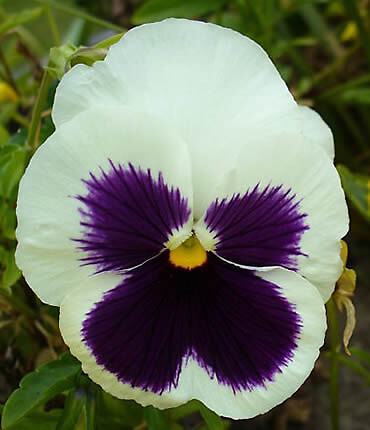All About Pansies
 To some of us, the pansy/viola is a happy, smiling face reminding us of a gardener friend from long ago. The first sign of that special flower brings a smile to our face and warmth to our heart. After all, this flower is known as the ‘pixie’ of the plant world. How perfect is that to have in your winter/spring gardens!
To some of us, the pansy/viola is a happy, smiling face reminding us of a gardener friend from long ago. The first sign of that special flower brings a smile to our face and warmth to our heart. After all, this flower is known as the ‘pixie’ of the plant world. How perfect is that to have in your winter/spring gardens!
Sunset Western Garden Book tells us that botanically speaking, members of the genus Viola, which includes the pansy, viola and violets, are perennials. We just happen to treat them as annuals. The varieties that we grow are happiest in cool weather and have become known as one of our best winter bedding plants. Planting them now ensures wonderful color in your spring gardens.
There are many different cultivars of pansies and violas offering a wide range of colors and flower sizes: colors from white, yellow, apricot, violet, blue-purples, dusty rose and combinations of all of these colors! The flower sizes range from 1-4 inches.
Pansies like sun to light shade. If you plant them in deep shade, they will grow, but not reward you with as many flowers. Plant them toward the front of your flower beds along with your shrubs and other flowering bedding plants such as Iceland poppies, alyssum, lobelia, nemesia and all. You may not want to put them too close to the edge if your planter is next to your grass (scary weed whackers may chop off their heads!). But these plants love to trail and would be beautiful in raised beds, planters and window boxes!
Sometimes our pansies don’t get a chance to grow up. Don’t be too hard on yourself. This is not happening because you have a brown thumb. At times that six-pack coming from the grower has baby plants containing a fungal disease called Rhizoctonia which causes “damping off.” In other words, the lower stem near the soil line with become constricted and dark brown. Usually, your little seedling pansy will die. That fungus thrives in wet soil. Knowing that this can be a problem, here are a few planting and care tips:
Plant the little root ball slightly high, or above soil level. This will keep the roots drier, especially after watering.
Water, but be careful to not to overwater.
Amend the soil with planting mix when planting to increase good drainage around the roots.
If you had a problem in one area of your garden with the fungus, switch and grow the pansies in another area for a year or so.
Once your pansies are getting established and blooming with smiling faces, don’t forget to deadhead. Removing the finished blooms will increase the number of blooms and bloom time.
And here is the number one rule: start your morning with a stroll into your garden to gaze on all of these smiling faces. Oh sure, you can take your cup of coffee or tea along with you, too.